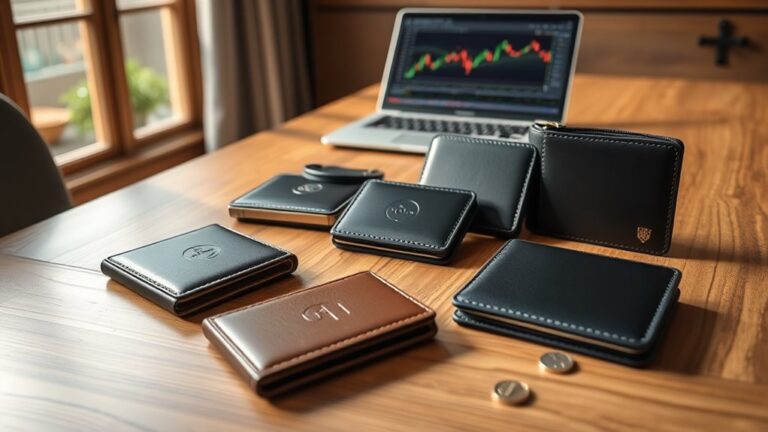
Best Platforms for Crypto Lending: Top 2025 Options Revealed
In 2025, top platforms for crypto lending include centralized options like Nexo and Binance, known for their user-friendly interfaces and instant loans. Decentralized platforms such as Aave and Alchemix offer innovative features, including peer-to-peer lending and self-repaying loans, respectively. Interest rates and loan-to-value ratios vary greatly across platforms, impacting user choices. Security measures like cold storage and multi-factor authentication are critical in protecting assets. Exploring these aspects can provide deeper insights into the crypto lending landscape.
Key Takeaways
- Centralized platforms like Nexo and Binance offer instant loans with competitive interest rates, up to 16% on Nexo.
- Decentralized options such as Aave and Alchemix provide unique features like self-repaying loans and flash loans without collateral.
- Loan-to-value ratios vary, with YouHodler offering up to 97%, while Binance typically provides 50% to 80%.
- User-friendly interfaces and innovative solutions enhance the accessibility and appeal of crypto lending platforms.
- Robust security measures, including cold storage and multi-factor authentication, are essential for protecting user assets on lending platforms.
Innovative Solutions for Crypto Lending

Innovative solutions in crypto lending are reshaping the financial landscape by leveraging technology to enhance accessibility and efficiency.
Decentralized lending platforms such as Aave and Compound utilize blockchain and smart contracts to facilitate peer-to-peer lending, allowing users to connect directly.
Alchemix introduces self-repaying loans, where yields from collateral effectively cover loan payments.
Automation and artificial intelligence streamline processes and improve credit assessments. Non-custodial options, like those from Summer.fi, grant users greater control over their assets.
Additionally, the integration of lending services into non-financial platforms increases convenience.
Mobile lending applications enhance financial inclusion, while alternative credit data sources, including social media and utility payments, broaden access for individuals with limited credit histories, making crypto lending more inclusive and user-friendly. Furthermore, DeFi lending offers a revolutionary alternative to traditional financial systems by ensuring rapid and open access to financial services worldwide.
Centralized Platforms: Features and Limitations

Centralized crypto lending platforms offer various asset management options, allowing users to choose different types of loans and interest rates. However, geographical availability can limit access for some users, as these platforms often operate within specific regulatory frameworks that vary by location. As a result, potential borrowers may face obstacles in utilizing these services, depending on their region. Additionally, these platforms provide competitive interest rates, making them an appealing alternative to traditional financial institutions.
Asset Management Options
While many investors seek opportunities in the cryptocurrency market, asset management options on centralized platforms offer a range of features and limitations that are important to understand.
These platforms operate within regulated environments, ensuring compliance with KYC and AML regulations, which enhances user protection. They typically provide fixed interest rates, allowing for predictable returns, and manage asset custody with robust security measures.
However, they are also subject to counterparty risks, including potential insolvency and regulatory changes that can affect operations. Additionally, these platforms may offer limited cryptocurrency options, primarily focusing on major assets like Bitcoin and Ethereum.
Despite these limitations, features like multi-signature custody and insurance options can enhance security and user confidence. Moreover, centralized platforms often attract users due to their high liquidity, which can lead to potentially more stable returns.
Geographical Availability Issues
Geographical availability issues present significant challenges for users of centralized crypto lending platforms.
While these platforms, such as BlockFi, Nexo, and Celsius, offer user-friendly services, their accessibility is often limited by local regulations. For instance, Binance Loans is unavailable in major markets like the U.S., U.K., and Canada. This restriction arises because centralized platforms must comply with specific laws in different regions, impacting their operational scope.
Users typically need to verify their location to access certain services, creating barriers for some individuals. Despite these limitations, these platforms often provide clear guidance regarding availability by country, aiding users in understanding their options. Although the lack of access in key markets can hinder overall user experience, the risk of security breaches also increases for those who use custodial lending platforms that operate in these restricted areas.
Decentralized Lending Options to Explore

Decentralized lending options such as Aave’s flash loans and Alchemix’s self-repaying loans offer innovative solutions within the crypto lending landscape.
Aave’s flash loans enable users to borrow assets without collateral, provided the loan is repaid within a single transaction block.
Meanwhile, Alchemix allows users to take out loans that are automatically repaid over time by leveraging yield farming, adding a unique twist to traditional lending practices. However, users should be cautious of the high risks associated with crypto lending, including borrower default and platform insolvency.
Aave’s Flash Loans
Aave’s flash loans represent a groundbreaking innovation in the decentralized finance (DeFi) landscape, allowing users to borrow funds instantly without collateral. This feature enables the borrowing and repayment of funds within a single Ethereum transaction, making it a unique offering in DeFi.
Aave pioneered uncollateralized loans, setting it apart from other platforms like Compound. Users must interact with Aave’s smart contracts to execute these loans, which cater primarily to experienced developers due to their technical complexity.
Flash loans can facilitate various financial strategies, such as arbitrage and debt liquidation, all while requiring no upfront capital. However, users must manage risks carefully, as failing to repay the loan within the transaction can lead to transaction reversion. Additionally, the rise of decentralized finance has led to a more inclusive and efficient financial ecosystem.
Alchemix Self-Repaying Loans
While traditional lending models often require substantial collateral and expose borrowers to liquidation risks, Alchemix offers a distinctive approach with its self-repaying loans.
This decentralized platform allows users to borrow against their crypto assets while the yield generated from these assets automatically repays the loan over time. By using synthetic versions of collateral, such as alUSD, borrowers reduce the risk of liquidation, as their original collateral remains intact.
Users can borrow up to 50% of their collateral’s value, ensuring a manageable collateralization ratio. Alchemix integrates with protocols like Yearn.Finance to maximize yield, providing a flexible financial tool that combines savings and lending.
The automated repayment feature enhances user convenience and promotes effective debt management. Additionally, this model allows users to access liquidity without selling their digital assets, potentially avoiding capital gains taxes while retaining ownership of appreciating assets.
Comparison of Key Features Across Platforms

When comparing key features across various crypto lending platforms, it becomes evident that users have a wide range of options tailored to their specific needs.
Interest rates vary considerably, with Nexo offering rates up to 16%, while YouHodler provides up to 7.5%. Loan-to-value (LTV) ratios also differ, with YouHodler presenting options up to 97%, while others like Binance typically offer 50% to 80%.
Supported cryptocurrencies range widely, with platforms like Radiant Capital supporting over 370 assets. User experience is enhanced by features such as instant loans and user-friendly interfaces on platforms like Nexo and Binance.
Finally, users can choose between centralized options like CoinLoan and decentralized alternatives like Aave, depending on their preferences. As the landscape evolves, new regulations are likely to influence lending practices and opportunities in the crypto market.
Security Measures and Risks in Crypto Lending

Security measures and risks in crypto lending are critical topics for anyone looking to engage in this fast-evolving financial landscape. Understanding these factors can help individuals make informed decisions.
Key security measures include:
- Cold Storage Usage: Keeping assets in offline storage to protect against cyber threats.
- Encryption and Authentication: Implementing strong encryption and multi-factor authentication to secure user accounts.
- Third-Party Audits: Regular audits by independent firms can enhance platform credibility.
However, risks persist, such as cybersecurity threats, regulatory compliance issues, and market volatility that can affect loan viability. Additionally, staying informed about phishing attacks is vital for protecting one’s digital assets in this environment.
Lenders and borrowers must remain vigilant about these risks while leveraging the security measures in place to safeguard their assets in the dynamic world of crypto lending.
Market Trends and User Adoption Insights

Market trends and user adoption insights reveal the growing significance of crypto lending in the financial landscape.
With over 5% of the global population owning digital currency and a user base exceeding 300 million, the demand for crypto lending services is substantial. The global cryptocurrency market cap, surpassing $1 trillion, highlights the potential scale of lending operations.
Adoption rates differ by region, influenced by economic conditions, technology, and regulation. Younger demographics, particularly male millennials, are leading this trend.
Users increasingly favor crypto lending for passive income opportunities, quick liquidity access, and diversified portfolios. Competitive interest rates and flexible loan terms are essential factors influencing user preferences and decisions in this evolving market. Additionally, maintaining a good loan-to-value (LTV) ratio is critical for mitigating risks associated with liquidation.
Frequently Asked Questions
What Cryptocurrencies Can I Use as Collateral for Loans?
Various cryptocurrencies can be used as collateral for loans, including Bitcoin, Ethereum, stablecoins, and select altcoins. Lenders typically prefer stable, liquid assets, emphasizing market stability and broad acceptance to mitigate risk.
How Long Does It Take to Get a Loan Approved?
Approval times for crypto loans vary considerably, typically ranging from 24 to 48 hours. Factors influencing speed include verification processes, collateral type, loan amount, and network conditions, contrasting sharply with traditional loan procedures.
Can I Repay My Loan in Different Cryptocurrencies?
In the domain of crypto lending, repayment options often resemble locked doors. Centralized platforms typically require the original borrowed currency, while decentralized ones might restrict repayments to stablecoins, limiting flexibility in traversing these financial landscapes.
Are There Fees Associated With Loan Origination or Repayment?
Fees are commonly associated with loan origination and repayment in crypto lending. Origination fees typically apply at loan initiation, while additional fees may occur during repayment, impacting the overall cost for borrowers considerably.
What Happens if I Can’t Repay My Loan on Time?
In the domain of borrowed treasures, failure to repay ignites a tempest. Late fees surge like rising tides, while collateral faces the axe, leaving the borrower adrift amid financial storms and potential losses. Awareness is key.
Conclusion
In the evolving landscape of crypto lending, various platforms offer unique solutions to meet diverse needs. Centralized and decentralized options each present distinct advantages and risks, creating a dynamic ecosystem for users. As market trends continue to shape user adoption, understanding the features and security measures of these platforms becomes essential. Traversing this complex terrain requires informed decision-making, ensuring that individuals can harness the potential of crypto lending while mitigating associated risks.












